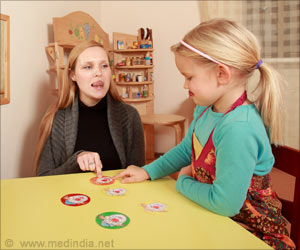The number of times an object enters an infant's field of vision tips the scales in favor of associating certain words with certain objects.

TOP INSIGHT
Children's first words are predictable based on their visual experience with objects and the prevalence of those objects in their visual world
"We think that children's first words are predictable based on their visual experience with objects and the prevalence of those objects in their visual world," said Smith, a professor in the IU Bloomington College of Arts and Sciences' Department of Psychological and Brain Sciences and senior author on the study.
"Visual memory may be the initial key to getting words stuck on objects - familiar visual objects like table, shirt, bottle or spoon," she added. "It's an aggregated experience; those very first words may be learned - slowly and incrementally - for a few visually pervasive objects. This may be how infants begin to break into language before their first birthday."
The study's results could also help inform interventions for children with delayed speech and other language disorders.
"Difficulty learning words could stem from visual processing problems," Smith added. "Children who are late talkers have slow or age-delayed visual processing skills for objects, for example. Children with autism have object-processing problems as well."
"While studying language acquisition from the 'word side' may benefit those studying later stages of language learning - at the ages of 18 months to three years - it cannot account for how children break into language," she said.
To conduct their study, IU researchers looked at videos that showed the visual field of eight children - five girls and three boys - between eight and 10 months old, the period before children engage in verbal interactions with parents and caregivers.
The videos came from head-mounted cameras worn by the children an average of 4.4 hours. Caregivers were told the cameras would observe children's daily activities, not words or objects specifically. Caregivers could choose when to activate the camera.
For the purpose of the study, researchers observed mealtime scenes, defined as any eating by anyone at any time or location - in cars, at playtime or in a high chair, for example. The recordings yielded 917,207 mealtime frames, with one image sampled every five seconds. Five objects were recorded for each frame: a total of 745 objects.
Using an accepted method to index child vocabulary, the researchers then divided the named objects into "first nouns," which are acquired by half of all 16-month-olds; "early nouns," which are known by half of all 30-month-olds; and "late nouns," which are acquired at later stages of learning.
First nouns include words such as table, shirt, chair, bowl, cup, bottle, food, spoon and plate.
The study's results revealed a strong correlation between the most frequently appearing objects and "first nouns," with the top 15 of these words appearing in the images collected by the study.
"The comparison of first and early nouns was particularly striking, since both sets of object names are acquired quite early in childhood and refer to objects common in households with infants," said Elizabeth Clerkin, a Ph.D. student in the IU Bloomington Department of Psychological and Brain Sciences and first author on the study.
"That infants' visual environment during mealtime consistently involves a very small number of objects - and the names of these high-frequency objects are among those normally learned first by infants - suggests visual experience is doing the heavy lifting in very early word learning," she added.
Whether children who experience speech disorders are not picking up visual regularities in the environment or simply live in households with fewer regularities, Smith said it's vital to explore the role of both words and vision in language learning.
"Taking account of the visual brings a whole new dimension of word-learning into view," she added. "If all you ever worry about is the word side of word-learning, you may be missing half the problem: visual cues that aid language learning."
Source-Eurekalert
 MEDINDIA
MEDINDIA



 Email
Email




